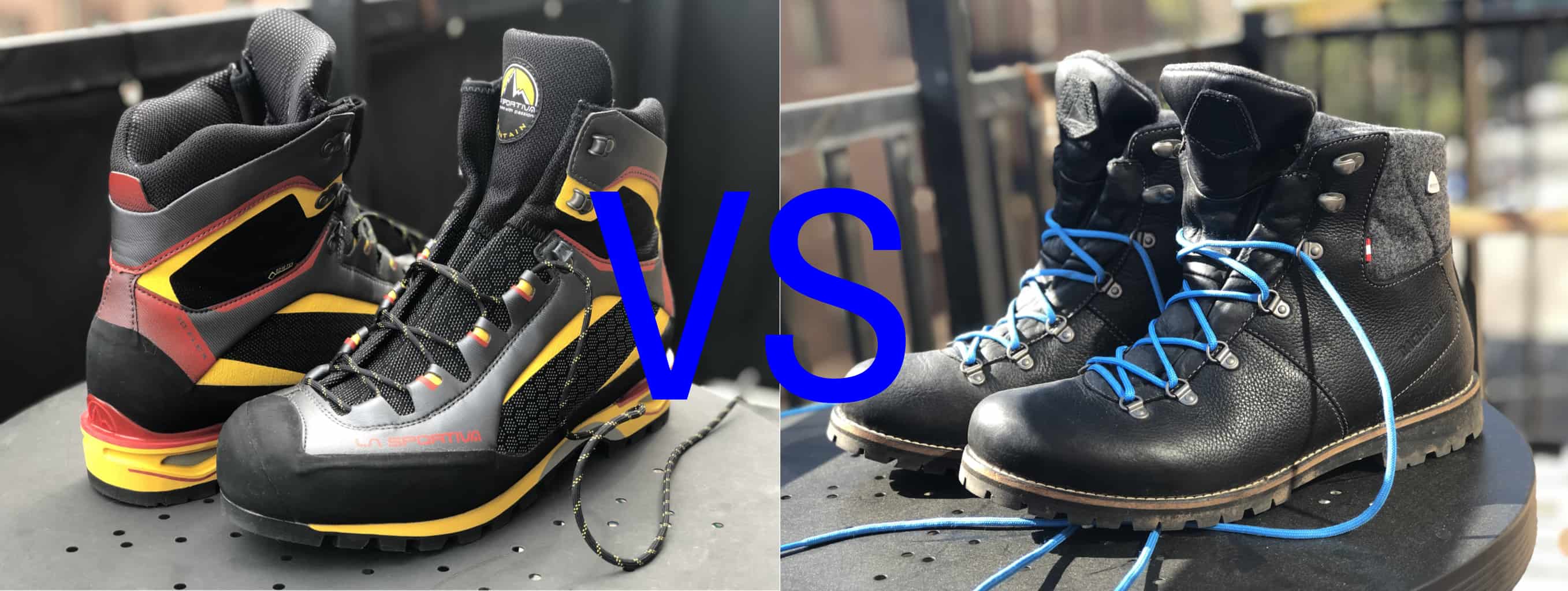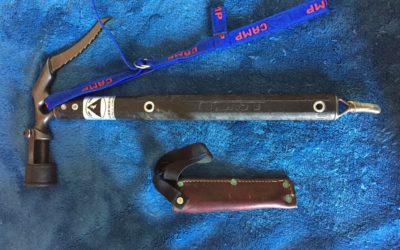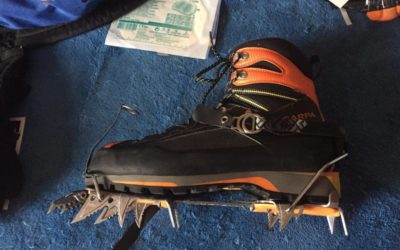
Before you leave for your outdoor escapades, it’s crucial that you tick off each item in your adventure gear checklist. For some essentials including backpacks, navigation tools, and water bottles, the decision is straightforward. Not so for footwear…
The main differences between hiking and mountaineering boots are weight, stiffness, price, range of use, tracks and range of purpose. For mountaineering on ice or with crampons, sturdy mountaineering boots are often preferable.
For some, mountaineering boots are all-conquering and will always rise to the occasion. For others, hiking boots are ever dependable and king of the trails. A good number sit on the fence. Indeed, even some veteran enthusiasts immensely struggle to pick between mountaineering boots and hiking boots.
Well, I decided to join the debate on who’s the boss between mountaineering boots and hiking boots. Let’s start with the basics:
Contents
What are Mountaineering Boots?
Mountaineering boots are special types of footwear specifically designed to help you move safely and easily over harsh terrain, especially glacial travels or daring ice climbs.
Their built helps support you in steep terrain where the ordinary boots could possibly cause an unsure footing and maybe a fall.
On the whole, mountaineering boots are constructed to work with crampons though many of the modern-day crampons are quite flexible and can be used with practically any boots.
Categories of Mountaineering Boots
It’s no secret that proper insulation is critical to prevent frostbites in extraordinary cold conditions. The incorporated synthetic insulation means that mountaineering boots can further be sub-classified as follows:
Single boots
Here the insulation is permanently attached to the boot. The insulating layer and the shoe effectively become one unit.
If it does wet out and freeze up, try to get to your tent or even below the snow lines to defrost them.
Double boots
In this case, a removable insulated liner is added to the non-insulated outer shell (leather or plastic). This arrangement allows you to remove and dry the liner inside your sleeping bag when it becomes drenched, making them brilliant for multi-day cold weather sojourns.
And what are hiking boots exactly?
Hiking boots are shoes specially built to protect your feet and ankles when mountain hiking. Principally, hiking boots are engineered to supply the comfort you need when walking considerable distances even over rough terrain.
In most cases, they are customized to protect your feet while the heels generally stabilize your gait when maneuvering on hills. These are super flexible and should be the first item on your list when planning for a weekend hike.
Types of hiking boots
Because hikers have diverse needs, boot manufacturers have innovated and released hiking boots to serve every season and terrain.
Here is a summary of the available classes:
Trail hikers
This is the footgear purposed for the steepest ascends and muddy paths. They are typically lightweight, higher-cut, sturdy, and watertight. These boots are thus more stable and better at ankle protection than common hiking shoes. They’re the surest bet when you’re hiking where rocks and protruding limbs are a real menace.
Trail shoes
If you’re testing your trekking skills during the dry season and on well-established and less rugged paths, choose trail shoes.
They are ideal for many fast-and-light day hikes, thru-hiking, and even ultra-light backpacking.
On the flipside, you will find them less stable and not as durable as the rest. They are, therefore, not the best for walking in areas where elements are a threat.
Backpacking boots
If you often haul heavy gear on your back during extended hikes and treks, backpacking hiking boots give you the extra cushioning and support needed to lighten your days.
Their design also makes them better equipped to conquer some elevation as well as significantly rugged terrain.
However, they’re still poor on tough alpine ascents and ice climbing.


Reinforced heels making the boot compatible with crampons. You can find the La Sportiva GTX on Amazon here.

How the heel on a typical hiking boot would look like. Often not compatible with crampons. Dachstein boots can be found on Amazon by clicking here.
Mountaineering Boots and Hiking Boots: The Similarities
The most remarkable similarity among these two boots is that they both possess qualities to quench your thirst for a thrill in the wilderness.
They actually go as far as using the same material in some instances.
There are even manufacturers promoting their hiking shoes as being versatile enough to be used for mountaineering.
Can you now see how close these ‘cousins’ are?
Mountaineering Boots vs Hiking Boots: The differences
Either way, you want footwear that refuses to take the easy route as the stakes rise out there.
Now, these two are great champions, BUT in separate ways. I will first contrast their constructions:
Materials: Mountaineering boots are made of plastic, leather, or other contemporary materials such as Kevlar. On the other hand, popular hiking boots may be made of nylon, split-grain leather material, and suede. Of course, as I had mentioned earlier, sometimes the two share materials. For example, it’s not uncommon to find both shoe types made of top-quality leather and suede.
Crampons: Traditionally, crampons are attached to mountaineering footwear to improve your mobility on ice and snow during technical ice climbing. And with their stiffness, crampons achieve better precision and makes climbing more difficult terrain a fun affair.
In contrast, crampons don’t naturally suffice with hiking boots. Sure, there could be exceptions with a bit of invention but overall, crampons are a big no for this class of expedition boots.
Weight: Considering that you are in danger of being swept away by rampaging ice and glaciers across snowfields, mountaineering boots are deliberately made heavy and thicker.
Hiking boots are, on the contrary, definitely lighter to let you walk with utmost ease even after clocking in the miles. Regardless, the idea is, in both cases, to serve moments you’ll never forget.
Mid-soles: To accept crampons and lug heavier cargo, mountaineering boots have extremely stiff mid-soles. Hiking shoes are again quite stark and instead have flexible mid-soles to make brisk walks possible and comfy.
Height: Mountaineering boots are typically taller. Coupled with the extra stiffness, this helps support your efforts in steep terrain besides ensuring you hold your own against the tormenting forces. Hiking boots prioritize ankle support and aren’t as tall.
Mountaineering Boots vs Hiking Boots: Pros And Cons
Ultimately, each of the boots can do your foot certain favors and some disfavors too.
Its time I took you through the specific advantages and disadvantages of each pair:
Pros of using Mountaineering Boots:
- Versatility: Thanks to latter-day technological developments, recent high-altitude climbing boots designs can handle diverse conditions and landscapes.
You can thus proudly don your mountaineering boots when venturing beyond the great white for countless tasks.
That explains why cable car operators, mountain rangers, snow-plow drivers, and even rescue paramedics seem fond of this footwear.
- Maximum safety: Climate change raises the danger of stumbling over rocks as you scale the Alps and other testing mountainous regions.
Now, since mountaineering boots are habitually higher, extra stiff, and well insulated, you can practice your lifetime hobby with confidence, knowing that you’re shielded against every hazard.
Throw in your pair of crampons and your cold weather excursions become nothing short of sensational.
- Best with heavy pack load: Mountaineering boots are more stiff-soled and more comfortable with bigger loads compared to hiking shoes with a flexible forefoot. And so this footwear is amazing if you find harder climbs exciting while loaded down.
Cons of mountaineering boots
- A touch too stiff: Across the globe, there is a backlash against some mountaineering boots excessive stiffness. And in reality, you are also likely to join the critics if you’re embarking on a backpacking trip, especially on established trails.
- Possibility of soaking wet: Mountaineering boots that aren’t waterproof can be hell. You see, snow may melt when you return to the car and wet everything creating a mess.
- Energy sapping: Mountaineering boots are by far heavier and bulkier than hiking boots so some of your energy is wasted dealing with the additional pounds. Needless to say, this could make your winter climbing very tiring even with lighter backpacks.
Pros of using Hiking Boots
- Comfort for longer walks: Hiking boots design focuses on your creature comforts when walking and exploring the great, therapeutic outdoors. These boot’s comfy-first approach means you can gobble up thousands of trail miles without injury particularly if you wear warm, sweat-wicking hiking socks.
- Ankle support: An outdoor shoe with superior ankle support is pivotal to happier hikes. And in most cases, the best hiking boots have exceptional ankle support and tend to prevent injuries better than their peers. The traction on uneven surfaces is also helpful for the stability of the whole feet.
- Lighter: Generally speaking, hiking boots weigh much less. As a result, you don’t struggle with overload like with mountaineering boots.
Cons of Hiking Boots
- Insufficient cushioning: Certain hiking boots are pretty uncomfortable due to shallow cushioning. You’ll still go through water, mud, and every obstacle but you may strain hiking in them after just a few hours. Similarly, I have met some with minimal feet support and which need longer breaking in.
- Limited functionality: Truth be told, hiking boots were never designed for snowcapped hills. I once went hiking with my first pair in the snow and I got completely soaked when coming down. Even the waterproof ones have their own problems including some being prone to slips because of questionable tread.
Which Is Better?
It all comes down on your plans:
If you are into sightseeing and shorter distances, hiking boots might be great. Additionally, you cannot go wrong with these boots if you will be spending a lot of time reconnecting with nature and harbor ambition to venture into long distance trekking.
But you are likely to be severely restricted if you take the same boot up herculean ice climbs. Instead, I recommend sturdier mountaineering boots for any hikes where you’ll be battling ice.
Remember to invest in decent hiking socks with either outdoor boot.
Mountaineering Boots vs Hiking Boots: FAQs
Okay, let’s now tackle your hard questions:
Can you hike in mountaineering boots?
Mountaineering boots are built stiff to make them adept at ice climbing. Consequently, they don’t bend easily and may feel more rigid making them somewhat difficult to walk in ordinary terrain.
On that account, it’s best to use hiking boots for regular hikes. As I insisted above, they are intensely comfortable and a whole lot easy to walk in.
That being said, it’s not uncommon to find curious hikers trying their luck hiking with mountaineering boots.
How do I choose a hiking boot?
For the best experience, your choice of hiking boots must fit snug and still provide enough wiggle room lest your toes suffocate or get blisters.
Sizing remains a controversial topic because each manufacturer seems to prefer its own measurement system. Despite this, it’s vital that you order only shoes your size to avoid the inconveniencing back and forth between you and the online seller.
This is what you do: Measure your feet appropriately then lookup the fitting size on the manufacturer’s sizing chart.
At the bare minimum, also check the boots quality, waterproofing, weight, and durability when buying.
Can I use crampons in hiking boots?
So, can you use crampons on your hiking boots if you encounter icing conditions?
Well, you’ll need to be creative to use them.
This is because of the lack of the stiff-shanked boot required to attach them safely to your boot.
Nevertheless, some companies make some models that can work on ultra-light hiking boots and seem to work, but only to an extent.
Indeed, you should avoid them for challenging mountaineering or typical ice climbing as they may not be safe when confronting this worthy adversary.
Conclusion
We all agree on one thing: Having the right shoes is key to having fun and success out there.
But as we have seen, mountaineering boots and hiking boots have glaring differences and each is suited to specific situations.
Are you heading to the peak of Mountain Washington and desire to have the moment of your lifetime? If so, you are better off with your favorite mountaineering boot.
In comparison, you should throw your weight behind hiking boots if you kind of adventure doesn’t involve audacious trekking in the neighboring mountains.
Lastly, adding some cool hiking socks will make sure your feet are all smiles. Happy adventures!
Written by Felix

About me
Hi! I’m Felix. When I’m not spending time out in the mountains, I like to write about my hobbies. That is how Mountain Homies was created. On this site, I try to gather all the juicy information about Mountaineering that I have learned since I started. Happy adventures!
Related Articles
9 Pros and Cons of Climbing in Ski boots
You’re heading to some awesome back country ice climbing crags for the day. The prize if awesome: pristine ice climbing routes that…
Ice Axe maintenance: Sharpening, Cleaning & Storing
When I’m undertaking any form of alpine mountaineering or ice climbing, I always end up using my ice axe. Extensively. I’ve tried to…
How Sharp Crampons Should Be & How to File Them
In short, the front points of crampons should be sharp as knives while the bottoms of the crampons shouldn’t necessarily be as sharp as…



